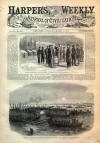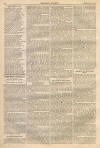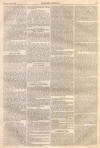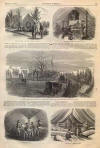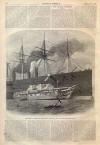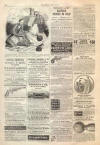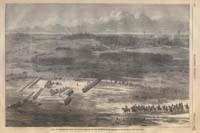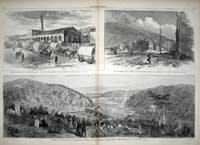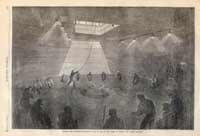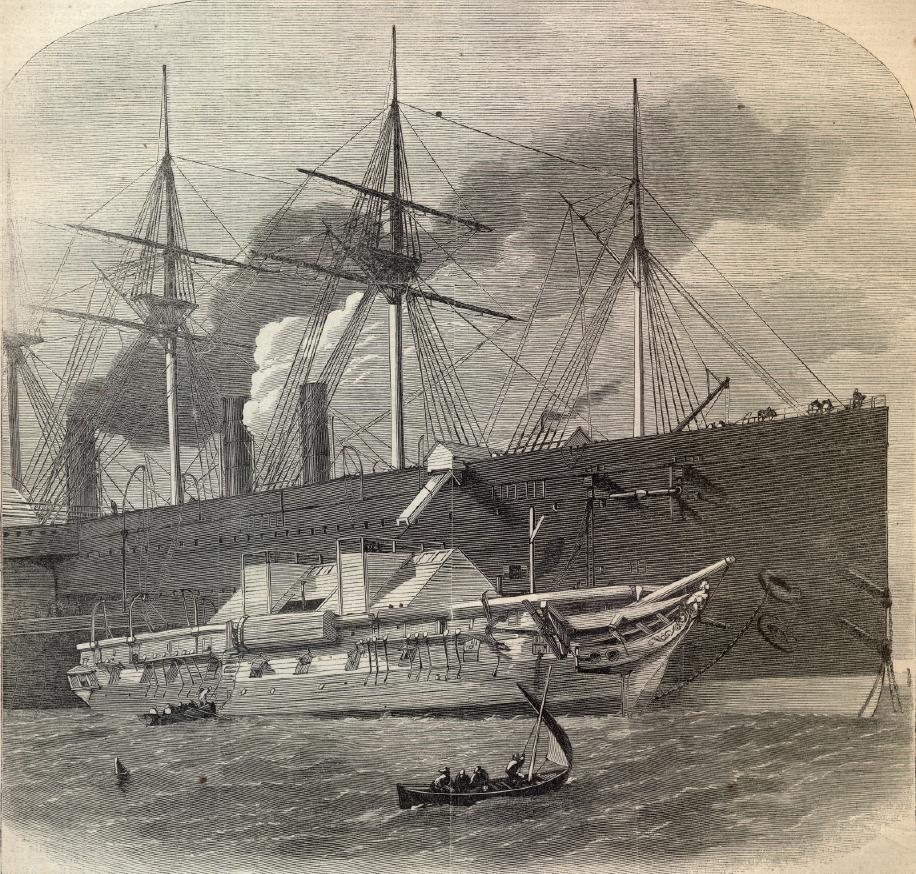|
This Site:
Civil War
Civil War Overview
Civil War 1861
Civil War 1862
Civil War 1863
Civil War 1864
Civil War 1865
Civil War Battles
Confederate Generals
Union Generals
Confederate History
Robert E. Lee
Civil War Medicine
Lincoln Assassination
Slavery
Site Search
Civil War Links
Revolutionary War
Mexican War
Republic of Texas
Indians
Winslow Homer
Thomas Nast
Mathew Brady
Western Art
Civil War Gifts
Robert E. Lee Portrait
|
either in depth of tone or
duration, of which latter assertion we have proof in the fact of the Greeks
having found purple robes in the treasury of the king of Persia that were known
to be two hundred years old, and vet were brilliant as ever that a very little
of this matter, which must, we think, have be n largely diluted, went a long way
in the process of dyeing. Another way was to draw the animal out of its shell,
squeeze it gently to obtain the much covet d liquor, and then allow it again to
retire into its house, the animal being restored to a tank to feed and gather
additional dye. This process was repeated till the animal became so weak and
worthless that it was thrown to feed other fish. Smaller shell, again were
entirely crushed in a kind of mill, and the liquor drained off for use. The tint
varied considerably it seems, according to the living and feeding-place of the
animal, just as it is found in the present day that the color and flavor of all
kinds of fish are dependent on the kind of water in which they live, and the
quality of the
is a suitable substance to write
with on either calico or silk ; the figures, in marking linen, will first, as
Mr. Cole tells us, appear of a green, then of a yellow color, and then by
successive changes will at last become purple. The mode of dyeing adopted by the
Tyrians was to gather all the liquor into a bath, in which, for a longer or
shorter period, always according to the intensity of color desired, they steeped
the wool or other substance which was to be colored.
After the wool had been immersed
for the requisite time in this preliminary bath, it was then thrown into a
boiler filled with the liquor of another variety of shell fish, and the stuffs
that under went this double process were very greatly esteemed and very costly,
each pound weight of the colored wool being valued at not less than thirty
pounds sterling ! In fact, the genuine purple was even more valuable than gold
itself. Immense quantities of the shell fish were required, because each pound
weight of stuff to be dyed required six pounds
THE
ATLANTIC TELEGRAPH
CABLE.
WE give on this and the next page
two illustrations one representing the Great Eastern lying in the Medway, and
receiving the Atlantic
Telegraph Cable from one of the hulks employed to bring
it from the manufacturers' yard at East Greenwich ; the other showing the manner
in which the cable is coiled and, stowed away on board the Great Eastern. That
mighty vessel, "hugest of all that swim the ocean deep," has undergone an
internal transformation to fit her for her new duties as a cable ship. The great
object was to get as few coils of cable as possible in fact, if possible, to
have it all in one. Large, however, as the Great Eastern is, she could never
hold the Atlantic Cable in one coil, for, apart from its weight, which is 5000
tons, its bulk in one mass would be gigantic a coil 58 feet in diameter and
nearly 60 feet high, enough to fill Astley's Theatre from the ground of the
circus almost to the
The work of shipping the cable
was begun on Thursday, the 19th ult., and will continue without intermission now
until nearly the end of May, by which time it is hoped all will be coiled away
snugly on board the great steamship. The total quantity of rope required to
connect Valentia with Bull's Bay. Newfoundland, allowing for the "slack" which
must run out to prevent too great a strain on the cable, is about 2300 nautical,
or nearly 2700 statute miles. With this length a liberal margin is given of
nearly 600 statute miles of rope for slack caused by currents, possible rough
weather, and the avoidance of any thing like unusual strain on the cable in the
deepest water. Over one part of the route the depth is as great as from 2000 to
2500 fathoms, or nearly throe statute miles a depth, however, which is only
considered of moment in case of rough weather in paying out, the mere strength
of the cable being sufficient to bear its own weight in eleven miles of still
water. In this respect as, indeed, in all others the new cable has an enormous
su-
THE "GREAT EASTERN" IN THE MEDWAY
RECEIVING THE ATLANTIC TELEGRAPH CABLE.
food they can obtain. The largest
and best fed Murice, of course, produced the finest dye.
A Bristol merchant of the name of
Cole leaves us some crude information on the subject of this dye, dated so far
back as 1684. This gentleman had heard through his correspondents of an
ingenious Irishman who gained a great deal of money by marking fine linen with a
beautiful purple color, the preparation of which was a secret only known to
himself. Setting out in search of this native genius, Mr. Cole was not long in
discovering that his fine coloring matter was obtained from a sea shell. Briefly
his directions, which apply to the whelk (Buccinum), are as follows : when the
shell has been lightly broken, throw the slug, i.e., the inhabitant of the
shell, into fresh water, where it will very speedily die. A white vein will then
be seen lying transversely next to the head of the fish, and the matter from
this vessel must be picked out with a camel hair pencil it forms the dye. This
of the dye liquor, which must, of
course, have been greatly diluted; but not even the well known fecundity of
shell fish could stand such a constant drain as was needed for the dye works ;
and of the quantities used we have evidence in the mounds that remain, so that
it is no wonder that in time the art was abandoned or lost, rather because of a
want of the raw material than from any tyrannical restriction in the
manufacture. If we wanted to resume the making of this purple nowadays an
eminent scientific man tells us that the best and cheapest way to manufacture it
would be, not from these shell fish, but from Peruvian guano. However, with the
brilliant aniline dyes of the nineteenth century there is no need for us to
reintroduce the Tyrian purple, even with the knowledge of the fact before us,
that we could artificially cultivate the "buckies',' in any required quantity,
in the same way as we can multiply our supplies of oysters or pearl mussels.
roof. It is disposed, therefore,
in three circular tanks one aft, one amidships, and one forward. Each of these
tanks is of solid wrought iron, watertight, built on what is called the 30-foot
deck, and, with some minute differences, all are nearly alike in size viz., 58
feet diameter and 20 feet high. The forward tank is, from the shape of the ship,
smaller in diameter than those amidships and aft, but the heights of all are
alike. This tank is shown in the engraving on our next page, with the first
portion of the cable. In order to sustain the enormous additional weight which
will be placed on the decks when the whole of the cable is on board, the deck on
which the tanks are erected is strengthened by a system of knees and deck beams,
while the lateral pressure of the cable against the sides of the tanks will be
overcome by an arrangement of beams and supports, with the object of confining
the dead weight of the cable to the centre of the ship, and overcoming all
outward pressure.
periority over the old and ill
used rope which was first laid, and which, to the amazement of all those who
knew its real condition, nevertheless remained in fair working order for a few
days. In size, in strength, in better condition, better insulation, and better
outer covering, the new rope is never less than three times as good as the old
one, while in many cases, and these the most important, its superiority is four
or five times greater. Though a much larger cable, its weight in water per mile
is less than half that of its unfortunate predecessor, its breaking strain is 7
3/4 tons against 3 1/4 tons, the maximum strength of the old rope. The method of
joining up the two mile lengths in which it is constructed is also a great
improvement upon the soldered joints in the wires of the first cable, while the
standards for insulation and " conductivity" are as high as those devised for
the Persian Gulf cable, and the tests are continuous in every portion of the
manufacture.
|
